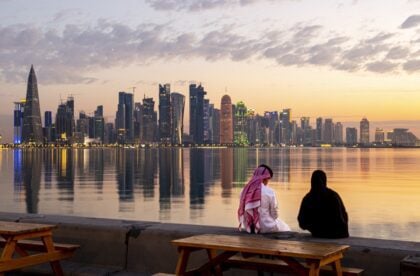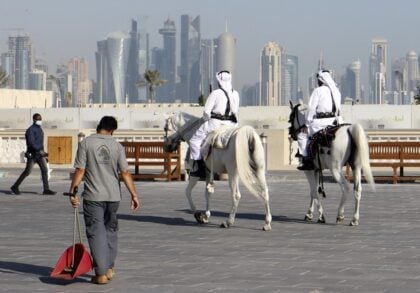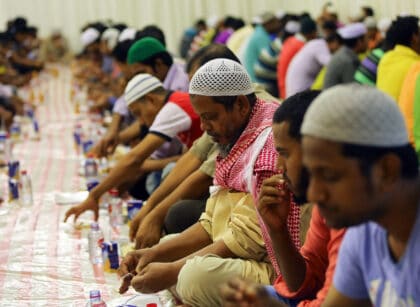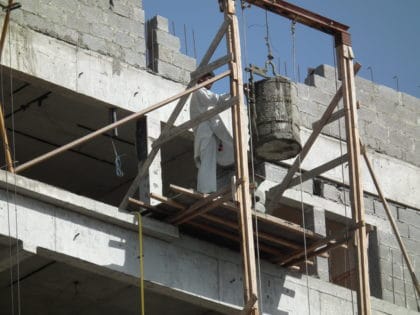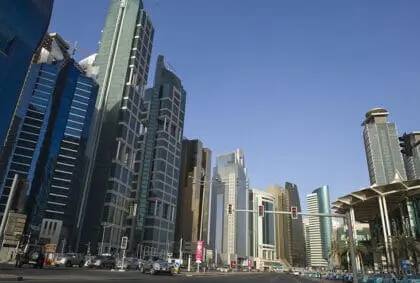
Introduction
Qatar’s legal system is based on Islamic and civil law codes. The system is controlled by the Emir. Islamic law dominates family and personal matters. The judicial branch includes Courts of First Instance, of Appeal, and of Cassation. An Administrative Court and a Constitutional Court were established in 2007. All judges are appointed by decree of the Emir, based on the recommendation of the Supreme Judiciary Council, for renewable three-year terms.
In 2002, a National Human Rights Committee was established by decree of the Emir. It is bound by guidelines set by the United Nations for National Human Rights Organizations.
Education is compulsory and free for all government employees’ children aged six to sixteen years old. Qatar has an increasingly high literacy rate of 89 percent (in 2008) and 99.3 % as of 2022. In the autumn of 2003 Education City was inaugurated, a billion dollar project funded by the Emir. Some of the best universities in the world have opened up local branches in Education City, a 2,500 acre desert campus outside the capital of Doha.
The most visible sign of the move of the Qatari society toward openness is the al-Jazeera satellite television station based in the country, which is considered the most free and unfettered broadcast source in the Arab world. In practice, however, al-Jazeera rarely criticizes the ruling Thani family.
Tribal Society
For centuries Bedouins (badu) have passed through the Qatar Peninsula – a strip of land extending northwards from the Arabian mainland to the Persian Gulf – benefitting from the sparse resources and at the same time maintaining their territorial interests with regard to other families in present-day Qatar, Bahrain and Saudi Arabia.
Records indicate that Qatar, in 628, was ruled by someone belonging to the Al Musallam, a tribe that was part of the larger Al Tamimi, one of the main tribes of Arabia whose history goes back to pre-Islamic times. Ottoman sources also confirm that the Al Musallam were in the Peninsula for the longest stretch of time and were still in charge in 1555.
The tribe was based at al-Huwayla. Until the arrival of the Utub tribe in 1783, three small settlements existed in the Peninsula: al-Huwayla, al-Fuwayrat and Doha. At the beginning of the 18th century, the Al Musallam was outnumbered, and the Peninsula was inhabited by other tribes.
The dispersed origins of these tribes, and their annual migratory patterns, demonstrate the degree of difficulty that was inherent in attempting to maintain control of the Peninsula. In the absence of a central authority, the coastal towns and villages were governed by local sheikhs.
In the 18th century, the coastal conditions were more favourable than in central Arabia, where the economy did not prosper and agriculture was limited. These factors shaped a new relationship between the coast and the hinterland, as the shoreline presented rich oyster beds for harvesting pearls.
The tribes from the interior increasingly began to move and settle in the coastal centres as the pearling industry became particularly lucrative. The tribal migrations that occurred around 1800 brought the tribes and clans that nowadays control Qatar, Kuwait, Bahrain and the United Arab Emirates.
Qatar’s society today is founded upon traditional tribal systems which have their origins in the region around the Peninsula. The hierarchical nature of society was based on the mainland tribes, although in the coastal areas, identity hinged more on commerce. Among the principal badu tribes who continuously migrated to and from the Qatar Peninsula after the Al Musallam were the Al Murra and Al Ajman from Hasa; the Al Manasir from Oman; and the Al Nuaim, roaming between Bahrain and Oman.
The majority of the non-sedentary tribes who grazed their stock in Qatar was merely transient. They owed allegiance to the Saudis, whom they paid jizya (tribute). Individual clans of the great Bedouin tribes such as the Al Murra, Bani Hajir and the Al Manasir made up a large segment of Qatar’s ethnic, migratory population.
They succeeded in acquiring the Qatari nationality when Qatar gained independence. Some of them even managed to secure a double nationality, enabling them to continue their seasonal migration between Saudi Arabia and Qatar.
One of the tribes that moved within a relatively small radius of the Peninsula was the Al Nuaim. The Al Nuaim, one of the Bedouin tribes who early on settled in the Qatar peninsula, numbering about 2,000 in 1908, was by far the largest semi-sedentary tribe. From about 1860 their dira (grazing area) was located in the hinterland of al-Zubara.
Partly sedentary, but overall pastoral, in the summer a large group of Al Nuaim would migrate by boat – with their camels, horses and sheep – to Bahrain. Others took up summer quarters near Doha.
Since 1800 most of the tribes of Qatar were however sedentary, and are more often than not of mixed ethnicity. The largest of the sedentary tribes that populated the coastal districts were the Al Sultan, Al Mahanda, Al Sudan, Hamaydat, Huwala, Al Bu-Aynayn, and the Al Bin-Ali. The majority of tribes in Qatar settled as town dwellers or hadar (people leading sedentary lives) in the 18th century.
They generated income mainly from pearl diving, fishing, trade and sea transport. Their economy was therefore oriented more towards the sea than to the desert. In addition, they owned camels, sheep, and goats, which were herded by Bedouins of the interior in the winter months. Some of the hadar tribes also took to the desert themselves during the colder season.
Their main objective was the grazing of their stock, but they may also have had a political motive. For example, Al Thani sheikhs used their desert camps to assert influence over the Bedouin tribes of Qatar.
In the late 1950s there were only about a thousand Bedouins still living in tents in the whole of Qatar. In 1960, the government started a settlement program, urging the remaining pastoral Al Nuaim to exchange their tents for the concrete houses of the newly built town of Al-Ghuwayriya.
Estimates in 2005 put the figure of the Al Murra between 5,000 and 10,000, suggesting that they accounted for anywhere between 2.5 to 5 percent of the Qatari population in that year. In 2004, a decree from the Emir stripped all members of the Al Murra of their Qatari nationality, expelling them to Saudi Arabia as they possessed dual Qatari and Saudi citizenship.
The ruling tribe
In the early 1800s, the main settlements in Qatar were associated with two tribes, the Al Thani and the Al Khalifa. The Al Khalifa had first established a settlement across the coastline of the Peninsula. Although the Al Khalifa tribe was successful in taking Bahrain, it did not succeed in holding Qatar.
The Khalifa tribe lost the Peninsula to the Al Thani, the leading tribe who belong to the Al Tamimi, which migrated eastward from central Arabia to the Qatar Peninsula and emerged as a dominant ruling family in the mid-19th century. The Al Thani tribe is composed of many fractions; three major branches can be defined: the Bani Hamad led by Khalifa bin Hamad; the Bani Ali led by Ahmad bin Ali; and the Bani Khalid led by Nasir bin Khalid. The Al Thani members are estimated at 1/5 of the Qatari population.
The second sheikh, Qasim ibn Muḥammad Al Thani (1878–1913), is considered to be Qatar’s founder. The seventh sheikh, Khalifah bin Ḥamad Al Thani (born 1932), was instrumental in obtaining Qatar’s independence from Britain in 1971 and became the first emir of the country. On 27 June 1995 he was deposed by his son Hamad bin Khalifa Al Thani (born 1952), who abdicated on 25 June 2013 in favour of his son Tamim bin Hamad Al Thani (born 1980).
Merchant families
Before the discovery of oil and petroleum development in Qatar, trade between the members of the tribes and the merchant class was one of the main factors in the tribal community. Two important merchant families in Qatar before the oil era were the Darwish and the Al Mana. Originally, the merchant class ran successful businesses, trading in all kinds of goods, pearling, smuggling and investing funds to ensure greater returns.
After oil production began, the merchant class branched out into areas such as banking sector, the automobile industry, real estate, and the media business. The traditional values of the desert saw the appropriation of wealth as a resource for redistribution, a central tenet of badu life.
The Darwish and the Al Mana maintain their influence and close interaction with the Al Thani today through joint business ventures and by providing advice to the Sheikhs on monopolies on supplying labor, housing, water, and goods to the oil company and concessions.
Nevertheless the interaction between the ruling tribe and the merchant class was governed by differences in social values. It is notable that intermarriage between the Al Thani and the merchant class is extremely rare. The Al Thani generally marry within their own tribe or from the Al Attiyah and the Al Misnad, binding these two tribes to them politically.
The commercial activities in the 1950s caused an increased politicizing of the Al Thani. As their resources and incomes grew, all male members were given the title ‘Sheikh’, a title previously only bestowed upon the head of a tribe. At the same time they were accorded a monthly stipend.
These initiatives created a political elite and new policy departing from the traditional socio-cultural patterns. No public dissent is tolerated in Qatar, opposition usually manifests itself in intrigues or behind-the-scenes grumbling by aggrieved parties.
A Society in Transition
When in November 2007 political scientist Louay Bahry returned to Qatar after three years of absence, he was surprised to find a female immigration officer issuing visas at the airport. He was even more amazed when he noticed that all the passport officials and luggage screeners were Qatari women.
Since the turn of the millennium, the country that was once notorious for its introspectiveness has modernized and ‘globalized’ at an astonishing speed. Qatar has opened up increasingly to foreign investment, tourists and products. Its luxury shopping malls are crammed with Western boutiques and fast food eateries.
Qatari families have developed a liking for Indian cuisine and Bollywood movies. Ambitious youngsters attend Weill Cornell Medical School in Education City, on the outskirts of Doha.
Two prominent women
Qatar is a society in social and moral transition: that is the image put forward by the ruling elite. It is no coincidence that two of the most prominent instigators of societal evolution are women: Qatar’s former First Lady Princess Sheikha Moza bint Nasir al-Misnad and Sheikha Abdullah al-Misnad, President of Qatar University. Former First Lady Princess Sheikha Moza bint Nasir al-Misnad is one of the Emir’s father’s wives, and the only one to appear in public.
Soon after her husband assumed power in 1995, Princess Moza founded the Qatar Foundation for Education, Science and Community Development. In the autumn of 2003 the Foundation officially inaugurated Education City, a billion dollar project funded by the former Emir from his personal assets.
Women in Qatar
Qatar can expect to see an increasing number of highly educated young women entering the job market. It remains to be seen how these women will cope with – or change – a still overwhelmingly male dominated country. In 2004, 3.6 percent of the overall workforce and 30.6 percent of the Qatari citizen workforce was female, rising to 16.6 % in 2022.
As of 2021/22, about 67.3 % percent of university students were female – and they were known to work harder and achieve higher grades than their male companions. Those who found a job typically entered economic sectors traditionally associated with women, notably education and medicine. Nevertheless, Qatari women can increasingly be found in the business and security sectors.
Article 35 of the Constitution stipulates that ‘there shall be no discrimination on account of sex’. However, a wide gap exists between the ideals of the Constitution and the actual situation. Although since 2005 women have received the same salary as men, they are not entitled to equal allowances (such as transportation and housing costs).
The testimony of one man still equals that of two women in court. And while women may attend court proceedings and represent themselves, they are still generally represented by a male relative. Girls can inherit only half as much as their brothers. Domestic violence continues to be a major problem, and marital rape is not legally considered a crime.
Perpetrators of so-called ‘honour killings’ can expect substantially lower sentences than ‘common murderers’. Tradition requires women to travel abroad with male escorts, and they are prevented from booking hotel rooms.
In 1997, the Emir announced that women would be granted the same rights as men to vote and to stand for office. This intention met with opposition from a group of more fundamentalist Islamic leaders, including a professor of history at Qatar University who was subsequently jailed for a hundred days.
At the first election of the 29-member Central Municipal Council in 1999 none of the female candidates gained a seat. When the Council was re-elected in 2003, Sheikha al-Jufayri became the first female councillor. But she faced no competition and with a meagre 38 percent, voters’ participation was even lower than in 1999.
In this context it is interesting to note that in recent, relatively free elections in the region – in Kuwait, the Occupied Palestinian Territories and Egypt – women did not vote differently from men when faced with the choice between liberal and conservative-Islamist candidates.
Education in Qatar
Before the 1950s, education in Qatar was dominated by traditional Koranic studies in accordance with the kuttab system. This is an elementary form of education that used memorization and recitation of the Koran in order to provide young Muslims with knowledge of the Holy Book, teaching them about the social and religious codes. Arithmetic and basic Arabic were also taught as a supplement.
Because of the relatively late development of the Arabian Peninsula, formal education did not start until 1951, when oil revenues began to flow. In that year, the first elementary school for boys was opened. Since household work was prioritized over a formal education for women, it was not until 1955 that a girls school was established. Both were situated in Doha.
By the end of the 1980s, there were 62,000 students attending 192 schools. However, educational standards remained relatively low, as a result of a lack of proper teaching qualifications and large class sizes. Most importantly, the educational system was imported from abroad, along with the teachers that had to service the schools.
These teachers introduced the educational systems of their own respective Arab states, mainly Egypt and Palestine, with Qatari teachers soon joining them. The new Ministry of Education supervised the process, but it was itself staffed mainly by expatriate Arabs. With the rapidly increasing oil prices, higher education was needed in order to meet the state’s demand for technically schooled students.
Tertiary education began in 1973, when the Emir of Qatar issued a decree proclaiming the establishment of Qatar’s first national College of Education. The college admitted 57 male and 93 female students in its first year.
After a few years, rapid development of the country made it necessary to expand the College of Education to accommodate new areas of specialization. In 1977, Qatar University was founded with four colleges: Education, Humanities & Social Sciences, Sharia, Law, & Islamic Studies, and Science. In 1980, the College of Engineering was established, followed by the College of Business & Economics in 1985.
Education in Qatar is compulsory and free for children between six and sixteen years of age. Primary school in Qatar is broken up into two stages, preparatory (six years) and elementary (three years). The six years preparatory schooling is compulsory. This is followed by secondary education (three years). The two sexes are segregated at all levels of schooling.
In 2008 there were 520 schools with a total of 146,000 pupils. According to UNESCO (figures for 2010) the net enrolment ratio in primary schools was 92 percent for boys and girls (the regional average was 98 percent), while in secondary schools it was 93 percent for girls and 76 percent for boys. The pupil/teacher ratio was 12 percent in 2010. As of 2022, there were 719 schools with 292,243 pupils with the average pupil/ teacher being 13 in primary school, 14 in preparatory school and 10 in secondary school.
Net enrolment for pre-primary schools was 51 percent (regional average 19 percent) in 2008. Ten percent (26 percent female, 5 percent male) of the population were in tertiary education (regional average 24 percent). All children in Qatar complete a full primary education curriculum, while the primary to secondary transition rate is 100 percent (2008).
There are a large number of international schools, where most expats and some Qataris prefer to send their children.
The Qatari authorities have announced their intention to spend more on education and youth welfare and health and social services in the years to come. The total expenditure on education was 3.3 percent of the GDP in 2005, and 8.2 percent of total government expenditure in 2010. The literacy rate for the overall population (above the age of fifteen) was 93.1 percent, while for the age group between fifteen and twenty-four years it was 99.1 percent.
Additional spending on education and health could help Qatar improve its standing on the Human Development Index (HDI), published by the United Nations Development Program (UNDP). Qatar clinched the 37th spot globally in HDI’s 2011 report. HDI ranks countries on the basis of income, health and education.
Knowledge economy
Qatar’s position in the world is strengthening, and this rapid development is influencing Qatar’s changing and developing relationships in the Gulf, the Arab region and the wider world. One of Qatar’s main focus areas is education. Sheikha Mozah Bint Nasser al-Misnad, the wife of the former ruler of Qatar and chairperson of the Qatar Foundation for Education, Science and Community Development, has spearheaded the promotion and development of higher education and science in Qatar.
The Qatar Foundation has induced some of the best universities in the world (see below) to open up local branches in Education City, a 2,500 acre desert campus.
Qatar Foundation for Education, Science and Community Development was established in 1996 and has grown to encompass a number of facilities for students from the age of three upwards. Its aim is to benefit and develop the state through initiatives in education, science and research. Under its aegis Education City has been established to the west of Doha comprising a number of foreign branch university campuses.
The Supreme Education Council directs three institutes designed to carry forward education initiatives in the State:
• the Education Institute which oversees and supports independent schools;
• the Evaluation Institute that monitors and evaluates both schools and students, and the
• Higher Education Institute which advises students on higher education both in Qatar and abroad, and administers grants and scholarships.
The campuses now comprise:
• Virginia Commonwealth – VCUQ
• Georgetown – SFS-Qatar
• Weill Cornell Medical College – WCMC-Q
• Northwestern University in Qatar – NU-Q
• CHN – now known as Stenden after its merger with Drenthe University
• École des Hautes Études Commerciales de Paris – HEC Paris, and
• University College London – UCL.
All of the above are from the United States except Stenden, which is from the Netherlands, HEC, a French business school, and UCL from the United Kingdom, which will focus on conservation, museum studies and archaeology.
In addition to the above there is also a Qatar University based in Education City, the Qatar Faculty of Islamic Studies – QFIS. There are also three educational centres based in Education City:
• The Learning Centre, and the
In addition to the above educational campuses, there are a number of other centres based in Education City. Three of them are based on research and industry:
• Rand-Qatar Policy Institute – RQPI
• Qatar Science and Technology Park – QSTP, and the
• Qatar National Research Fund – QNRF.
In its own words, the Qatar Foundation aims that the project is ‘an international leader in progressive education and cutting-edge research’, with promises ‘to reform Qatar into a knowledge-based society’.
The government hopes to get foreign universities to share research and facilities, not only with each other but also with businesses and institutions in the public and private sectors. In 2004, Qatar established the Qatar Science & Technology Park at Education City to link universities based there with industrial partners.
The drive for social and educational reform among segments of Qatar’s ruling elite is partly aimed at security and political stability. The regime will be relatively secure in an affluent and stable nation.
But there are many ramifications in the process of linking economic development to international higher education. The collaboration needed in regional and global terms has not been translated into successful operational relationships, leading to insufficient working campuses. Also, the introduction of Western educational establishments and their academic staff and students will interact with traditional socio-cultural values, regardless of the pedagogical and educational processes involved.
Although building a stronger foundation for Qatar’s youth has been applauded as a model for education reform, there is skepticism in introducing foreign universities and their staff to develop and improve national educational performance, which effects are heard not only within the country but as well as in the wider Arab region.
Qatar University
In 1973, Qatar’s first national College of Education was founded following a decree by the Emir of Qatar. Among a small population, the college admitted 57 male and 93 female students in its first year.
By the end of 1989, 6,082 students had graduated from Qatar University (QU) of whom about 5,000 were Qataris. Today, QU comprises seven colleges: Arts and Sciences; Business and Economics; Education; Engineering; Law; Pharmacy; and Sharia and Islamic Studies. The university has over the years added a wide range of new programs. It currently boasts a population of over 8,000 students and an alumni body of over 30,000.
In 2003, QU embarked on an ambitious Reform Plan to increase the efficiency of its administrative and academic processes. This national institution was in dire need of reform. According to Louay Bahry, then chair of QU’s Public Administration, virtually every Qatari student was assured of obtaining a degree ‘even if they did not attend class regularly’.
Qatari faculty members were appointed for life without any system of assessment, while foreign professors were in constant fear of not having their short-term contracts renewed. Both were inclined to award high grades as a standard – if only to avoid attracting attention in a negative way.
The new President, Sheikha Abdullah al-Misnad, has tried to raise the academic level of the institute by (among other things) expelling some seven hundred students and removing eight hundred employees, who were mainly concerned with keeping up appearances. To this end, a university-wide Strategic Plan 2010-2013 was launched, incorporating Key Performance Areas that focus on promoting quality education and efficient and effective services.
The Plan also placed research and community service as key priority areas in accordance with the goals outlined in the university’s mission and vision. In drafting the Plan, the organization aligns its goals and expectations with Qatar National Vision 2030.
The academic climate seems to have improved considerably, although there are still many obstacles to overcome. Most significant is the gender gap, both in enrolment and attainment, which varies between 76 percent for female students and 24 percent of male students in 2010. This is a serious issue that has consequences for the workplace.
Qatari nationals make up a minority of the population and their net growth rates are lower than those of foreigners within the country. In order to service the infrastructural and economic boom, much of the workforce is imported. However, Qatar wishes to maximize or at least optimize the proportion of nationals in the workforce.
To take advantage of the range and character of opportunities available, it is essential that the workforce – particularly the nationals – are both well-educated and skilled.
In a report published by the Qatar Statistics Authority (QSA), Sheikh Hamad bin Jabor bin Jassim Al Thani, President of QSA, attributed low male students’ enrollment rates to a ‘weak drive towards higher education, lack of coordination between general education and the requirements of higher education.
Especially in those fields of specialization required by knowledge-based economy, availability of attractive jobs which do not require post-secondary qualifications, in some sectors, lack of Qatari families’ interest in furthering their education’. He referred to the social consequences of the phenomenon of students turning away from higher education, ‘causing dislocation at the family level as a result of differing education and cultural levels between husband and wife, and demographic dislocation arising from the need for foreign labor.
In addition, educated people enjoy security and national feelings. He warned against economic consequences if the phenomenon persists leading to the difficulty of implementing Qatarization strategies and adverse effects on the country’s drive towards knowledge-based economy, which requires high scientific and vocational qualification.’
Health in Qatar
Health care is generally of a high standard in Qatar. Qatari males have an average life expectancy of 76.1 years, and females of 76.9 (figures 2005). As of 2022, the life expectancy of the Qatari population was 81.7. All births are attended by skilled health personnel, and the infant mortality rate is a relatively low 6.54 percent. However, it is not clear how these figures reflect the situation among non-citizens.
Officially, all residents have access to free medical services but in practice non-citizen residents receive only very limited health care. HIV positive foreigners are deported to their home country. HIV positive citizens are quarantined and receive professional treatment. Statistics on the incidence of HIV and AIDS are not available.
There are nine hospitals in Qatar, five of which are government operated and four which are privately run. In 2006, there were a total of 2077 hospital beds, which equates to approximately 25 beds per 10,000 of the population compared to 767 in population per bed in 2021. Some of the main hospitals include the Hamad General Hospital, which has 616 beds covering all general medical areas, and specializes in paediatrics, surgery and internal medicine; the Rumaillah Hospital, and the Amal Hospital, a groundbreaking specialist centre for the testing, treatment and rehabilitation of cancer patients.
In 2006, there were 27.6 physicians and 73.8 nurses, 25.2 beds per 10,000 of the population (in Bahrain it was 27/10,000, in Oman 21/10,000). The immunization rate of one year olds is above 90 percent. In 2021, there were 329 population per physicians and 115 population per nurse staff
Health care in Qatar is regulated by the National Health Authority. The expenditure on health care was 9.7 percent of total government expenditure in 2006. Compared with neighbouring countries: the government expenditure on health as percentage of total government expenditure was 9.5 percent in Bahrain, 4.9 percent in Kuwait, 5.4 percent in Oman and 8.7 percent in Saudi Arabia.
In recent decades, Qataris have come to experience the typical health problems of a welfare state. The rise in cardiovascular diseases and diabetes related ailments has led to a spectacular increase in demand for hospital beds. Tiny Qatar now has the third largest demand for hospital beds in the Gulf Cooperation Council.
Diabetes has become a national curse. There are no official figures on this disease in Qatar, but there is no reason to assume that its population is less vulnerable than the nearby United Arab Emirates – which has the world’s highest rate of citizens suffering from diabetes: 19.5 percent.
Freedom of Expression
Immediately after his coup in 1995, Emir Hamad bin Khalifa promised his subjects freedom of expression. This was clearly an effort to broaden his power base, which at that time was limited to the army and reform minded sections within the family. But it was also part of a broader drive to change the image of Qatar, and make it stand out in a positive way from its neighbours.
Hamad’s initial supporters – keen on attracting more foreign investors – wanted Qatar to emerge from Saudi Arabia’s oppressive shadow. The Al Thani’s Wahhabi brothers in the Kingdom of Saudi Arabia faced serious problems in opening up their country to the global economy, in part because the foreign media typically labels the country as politically unstable, conservative, and corrupt.
One of the first signs that Qatar was liberalizing was the 1996 cabinet reshuffle. When all the new ministers had taken their seats, the chair formerly occupied by the dreaded Minister of Information was empty. Two years later the Ministry of Information was abolished. Its tasks had quietly been transferred to two other ministries – the Ministry of Foreign Affairs and the Ministry of Culture, Arts and Heritage – but this could not dampen the overall reform spirit.
The quasi abolition of official censorship coincided with the rise of the trendsetting al-Jazeera satellite television channel, founded in 1996. The breaking of social taboos by its slick modern show hosts and the airing of opposition voices (not from within Qatar) assured its practically instant success. Almost overnight, Qatar had achieved the image of a self-confident, tolerant and forward looking modern country.
Crime in Qatar
Violent street crime is rare in Qatar. As in all Gulf Arab countries, social control is strict and punishments, often corporal, can be severe. However, the local media sometimes report that migrants are stopped by nationals posing as police officers who ask for their passports and money before leaving them stranded and penniless by the road.
The most common local offence is government corruption, but nationals are inclined to consider this phenomenon a time-honoured tradition, as opposed to real crime. ‘Real’ crime according to both local and international standards, is often connected with drugs trafficking. Local and foreign gangs cater for the national market and traffic drugs from Asia – mostly Afghanistan – to the West.
In 2007 the UN Special Rapporteur (UNSR) on Trafficking in Persons claimed that Qatar is a destination for human trafficking, and is sometimes used as a transit country. The victims are mostly trafficked for forced labour and sexual exploitation. The UNSR criticized the lack of legal protection, which makes migrants extremely vulnerable to trafficking by organized gangs. These gangs are typically involved in interconnected criminal activities such as money laundering, drugs and weapons trafficking, extortion, visa fraud, usurious loans and profiteering.
Latest Articles
Below are the latest articles by acclaimed journalists and academics concerning the topic ‘Society’ and ‘Qatar’. These articles are posted in this country file or elsewhere on our website:


